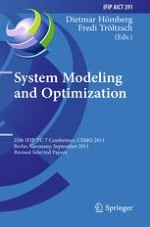2013 | Buch
System Modeling and Optimization
25th IFIP TC 7 Conference, CSMO 2011, Berlin, Germany, September 12-16, 2011, Revised Selected Papers
herausgegeben von: Dietmar Hömberg, Fredi Tröltzsch
Verlag: Springer Berlin Heidelberg
Buchreihe : IFIP Advances in Information and Communication Technology
